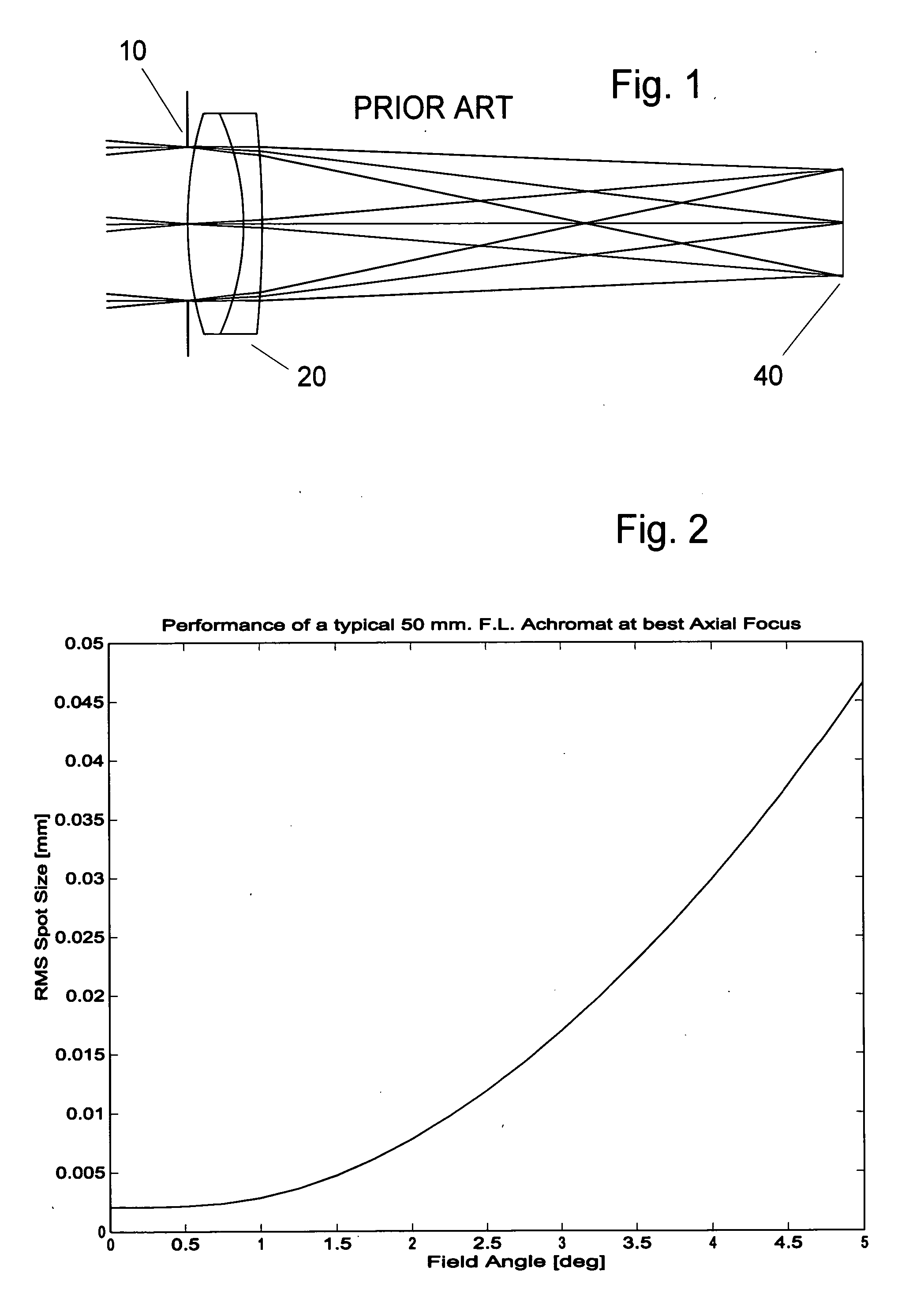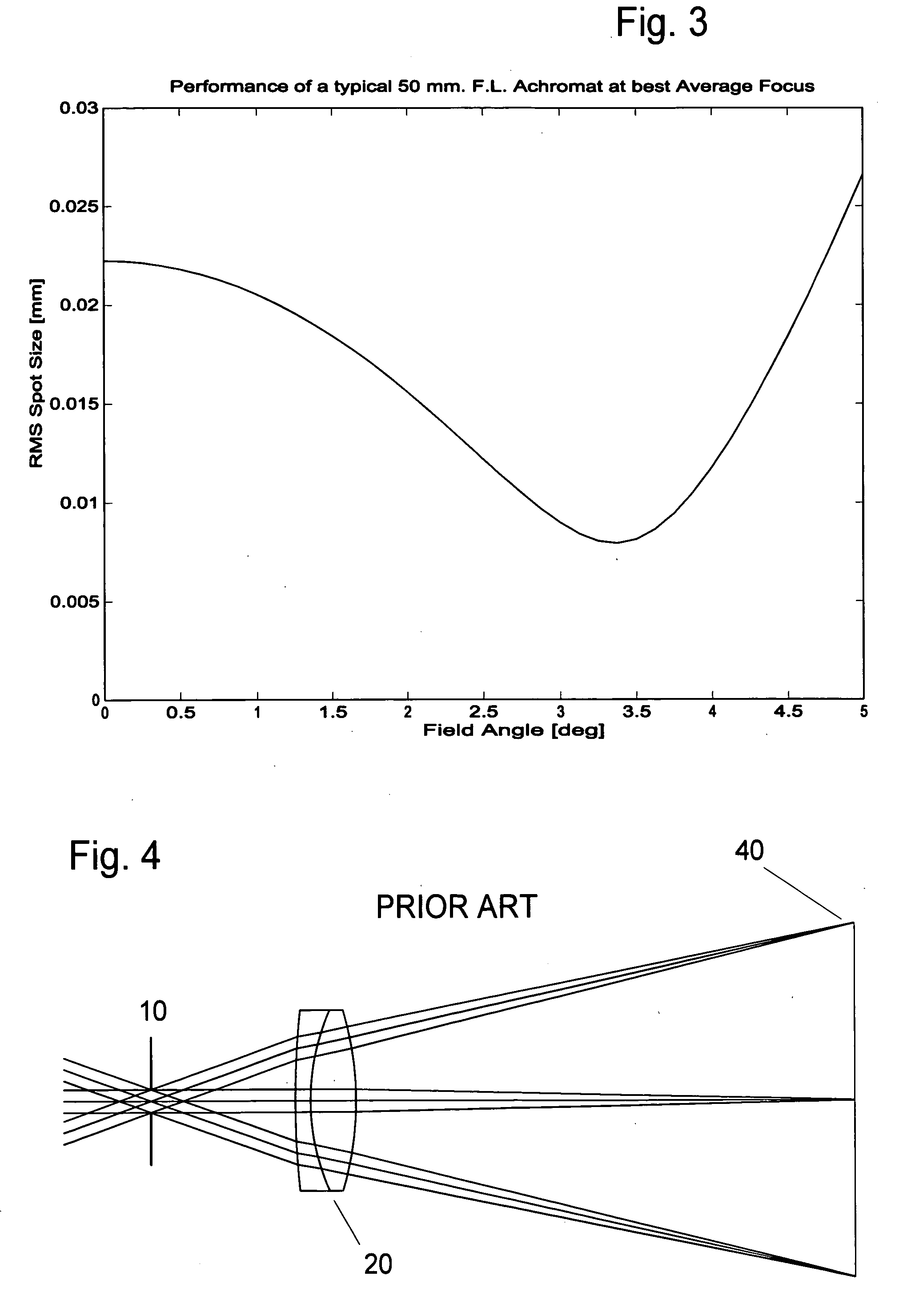Providing optical systems having improved properties to users of catalog (stock) lenses
- Summary
- Abstract
- Description
- Claims
- Application Information
AI Technical Summary
Benefits of technology
Problems solved by technology
Method used
Image
Examples
first embodiment
[0177] my new system is depicted in FIG. 10 and its construction details are presented in Table 1. The arrangement in FIG. 10 comprises a remote stop 10, an achromatic doublet 20 that I call the primary, and a second doublet 60, specially designed for this application, that I call the companion. As before, the image is viewed on an image viewing plane 40. Companion 60 is composed of an element having a positive focal length, 30, and an element having a negative focal length, 38.
[0178] In the case shown, the primary has a focal length of 100 mm, and is based on catalog Part Number 32500 as provided by the Edmund Optics company of Barrington, N.J. By “based on” what I mean is that the surface curvatures, thicknesses, and glass types of primary doublet 20 are those specified by the manufacturer, but that the aperture of the lens has been increased to its maximum feasible value, Amax, so as to minimize vignetting in various of the embodiments I discuss below. I refer to this specific pr...
embodiment 1
[0179] I refer to the system depicted in FIG. 10 as a “companion combination”. Since my new system includes both the companion 60 taken by itself, and the combination of the companion with a primary achromat, I will refer to two types of embodiments. The embodiments of companions themselves will be referred to as “companion embodiment”, and these will be designated by embodiment numbers. Embodiments of companion combinations will be referred to as “combination embodiments” and these will take the number of the associated companion and may have an associated letter suffix if necessary to distinguish combination embodiments that use the same companion. Thus, Table 1 gives the complete design structure of both companion embodiment I and combination
[0180] The data display of Table 1 will be quite familiar to those skilled in the art. It defines a pair of cemented doublets, the first being oriented so that its positive focal length element is facing the object and the second being orient...
embodiment 3
[0195] Likewise, my embodiment 3 is included here primarily for structural reasons, but notice that its performance is superior to all the other lenses shown in FIG. 14 over the region from about F / 7.5 to F / 5. Note also that the performance of Schade's Petzval is superior to all other lenses in the Figure from about F / 5 down to where it cuts off at about F / 2.1. I will use the performance of Schade's lens as a reference for discussing the performance of my other Type 1NR embodiments.
[0196] I emphasize here that the performance curves of FIG. 14 and all the following performance figures have been generated for each lens being considered by allowing the position of the entrance pupil to vary to produce the best average RMS spot for each combination of focal ratio and field of view being analyzed. The construction tables and lens drawings necessarily represent each lens at a single specific combination of focal ratio and field of view. For my embodiments, the entrance pupil position sho...
PUM
 Login to View More
Login to View More Abstract
Description
Claims
Application Information
 Login to View More
Login to View More - Generate Ideas
- Intellectual Property
- Life Sciences
- Materials
- Tech Scout
- Unparalleled Data Quality
- Higher Quality Content
- 60% Fewer Hallucinations
Browse by: Latest US Patents, China's latest patents, Technical Efficacy Thesaurus, Application Domain, Technology Topic, Popular Technical Reports.
© 2025 PatSnap. All rights reserved.Legal|Privacy policy|Modern Slavery Act Transparency Statement|Sitemap|About US| Contact US: help@patsnap.com



